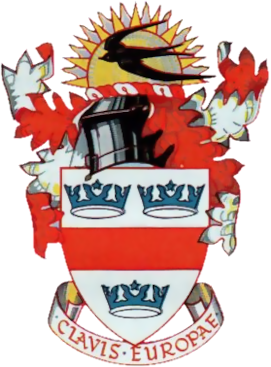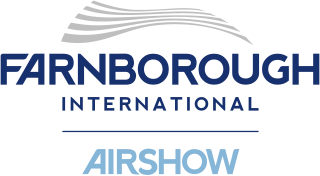
The Airbus A300 is Airbus' first production aircraft and the world's first twin-engine, double-aisle (wide-body) airliner. It was developed by Airbus Industrie GIE, now merged into Airbus SE, and manufactured from 1971 to 2007.

The British Aircraft Corporation (BAC) was a British aircraft manufacturer formed from the government-pressured merger of English Electric Aviation Ltd., Vickers-Armstrongs (Aircraft), the Bristol Aeroplane Company and Hunting Aircraft in 1960. Bristol, English Electric and Vickers became "parents" of BAC with shareholdings of 20%, 40% and 40% respectively. BAC in turn acquired the share capital of their aviation interests and 70% of Hunting Aircraft several months later.

The Airbus A310 is a wide-body aircraft, designed and manufactured by Airbus Industrie GIE, then a consortium of European aerospace manufacturers. Airbus had identified a demand for an aircraft smaller than the A300, the first twin-jet wide-body. On 7 July 1978, the A310 was launched with orders from Swissair and Lufthansa. On 3 April 1982, the first prototype conducted its maiden flight, and the A310 received its type certificate on 11 March 1983.

A jet airliner or jetliner is an airliner powered by jet engines. Airliners usually have two or four jet engines; three-engined designs were popular in the 1970s but are less common today. Airliners are commonly classified as either the large wide-body aircraft, medium narrow-body aircraft and smaller regional jet.

British European Airways (BEA), formally British European Airways Corporation, was a British airline which existed from 1946 until 1974.

The Vickers VC10 is a mid-sized, narrow-body long-range British jet airliner designed and built by Vickers-Armstrongs (Aircraft) Ltd and first flown at Brooklands, Surrey, in 1962. The VC10 is often compared to the larger Soviet Ilyushin Il-62, the two types being the only airliners to use a rear-engined quad layout, while the smaller business jet Lockheed JetStar also has this engine arrangement.

The Vickers Vanguard was a short/medium-range turboprop airliner designed and produced by the British aircraft manufacturer Vickers-Armstrongs.

The BAC One-Eleven is an early jet airliner produced by the British Aircraft Corporation (BAC). Originally conceived by Hunting Aircraft as a 30-seat jet, before its merger into BAC in 1960, it was launched as an 80-seat airliner with a British United Airways (BUA) order on 9 May 1961. The prototype conducted its maiden flight on 20 August 1963, and it was first delivered to BUA on 22 January 1965. The 119-seat, stretched 500 series was introduced in 1967. Total production amounted to 244 until 1982 in the United Kingdom and between 1982 and 1989 in Romania where nine Rombac One-Elevens were licence-built by Romaero.

The British Aerospace 146 is a short-haul and regional airliner that was manufactured in the United Kingdom by British Aerospace, later part of BAE Systems. Production ran from 1983 until 2001. Avro International Aerospace manufactured an improved version known as the Avro RJ. Production for the Avro RJ version began in 1992. Later on, a further-improved version with new engines, the Avro RJX, was announced in 1997, but only two prototypes and one production aircraft were built before production ceased in 2001. With 387 aircraft produced, the Avro RJ/BAe 146 is the most successful British civil jet airliner program.

The Fokker F28 Fellowship is a twin-engined, short-range jet airliner designed and built by Dutch aircraft manufacturer Fokker.

The Rolls-Royce RB211 is a British family of high-bypass turbofan engines made by Rolls-Royce. The engines are capable of generating 41,030 to 59,450 lbf of thrust. The RB211 engine was the first production three-spool engine and turned Rolls-Royce from a significant player in the aero-engine industry into a global leader.

The Rolls-Royce Spey is a low-bypass turbofan engine originally designed and manufactured by Rolls-Royce that has been in widespread service for over 40 years. A co-development version of the Spey between Rolls-Royce and Allison in the 1960s is the Allison TF41.

The Fairey Rotodyne was a 1950s British compound gyroplane designed and built by Fairey Aviation and intended for commercial and military uses. A development of the earlier Fairey Jet Gyrodyne, which had established a world helicopter speed record, the Rotodyne featured a tip-jet-powered rotor that burned a mixture of fuel and compressed air bled from two wing-mounted Napier Eland turboprops. The rotor was driven for vertical takeoffs, landings and hovering, as well as low-speed translational flight, but autorotated during cruise flight with all engine power applied to two propellers.

The Farnborough International Airshow is a trade exhibition for the aerospace and defence industries, where civilian and military aircraft are demonstrated to potential customers and investors in Farnborough, Hampshire. Since its first show in 1948, Farnborough has seen the debut of many famous aeroplanes, including the Vickers VC10, Concorde, the Eurofighter, the Airbus A380, and the Lockheed Martin F-35 Lightning II. At the 1958 show, Hawker Hunters of the RAF's Black Arrows executed a 22-aircraft formation loop, setting a new world record.
British Airtours was a charter airline in the United Kingdom with flight operations out of London Gatwick and Manchester Airports.

The Hawker Siddeley HS-121 Trident is a British airliner produced by Hawker Siddeley. In 1957, de Havilland proposed its DH.121 trijet design to a British European Airways (BEA) request. By 1960, de Havilland had been acquired by Hawker Siddeley. The Trident's maiden flight happened on 9 January 1962, and it was introduced on 1 April 1964, two months after its main competitor, the Boeing 727. By the end of the programme in 1978, 117 Tridents had been produced. The Trident was withdrawn from service in 1995.

The aerospace industry of the United Kingdom is the second-largest national aerospace industry in the world and the largest in Europe by turnover, with a global market share of 17% in 2019. In 2020, the industry employed 116,000 people.

The Armstrong Whitworth AW.681, also known as the Whitworth Gloster 681 or Hawker Siddeley HS.681, was a projected British long-range STOL military transport aircraft design of the early 1960s. Developed by manufacturer Armstrong Whitworth Aircraft, it was intended to be capable of achieving both Short Takeoff and Landing (STOL) and Vertical Takeoff and Landing (VTOL) performance.

The Bristol Type 200 was a proposal for a short-range aircraft by the Bristol Aeroplane Company in 1956. Although it was designed in response to a specification issued by British European Airways (BEA), the Type 200 was larger than the airline's requirements and was closer to the Boeing 727 in size and range. The project was cancelled when BEA selected the Hawker Siddeley Trident instead. The Trident went on to have a production run of 117, while the 727 had a production run of over 1800. Along with the Vickers V-1000, it is seen by some as one of the great "what ifs" of British aviation, although it never got beyond the drawing board.
Today's Airbus is the product of international consolidation in the European aerospace industry tracing way before the formation of the Airbus Industrie GIE consortium in 1970. In 2000, the European Aeronautic Defence and Space Company (EADS) NV was established through the merger of Aerospatiale-Matra of France and DASA from Germany, and that subsequently bought Construcciones Aeronauticas from Spain. In addition to other subsidiaries pertaining to security and space activities, EADS owned 100% of the pre-existing Eurocopter SA, established in 1992, as well as 80% of Airbus Industrie GIE. In 2001, Airbus Industrie GIE was reorganised as Airbus SAS, a simplified joint-stock company. In 2006, EADS acquired the remaining 20% shares of Airbus Industrie GIE from BAE Systems. EADS NV was renamed Airbus Group NV in 2014 and finally Airbus SE in 2015. Due to the commercial aircraft division's prominence within Airbus SE with it representing the largest part of the corporation's activities, Airbus S.A.S was published to be merged into the parent company in January 2017, but it was never done. Airbus SE remains therefore as the holding company for the commercial aircraft subsidiary Airbus SAS, while also being the parent company of the other two divisions Airbus Defence and Space and Airbus Helicopters.

















